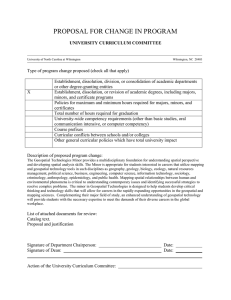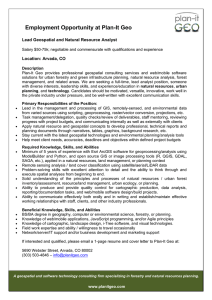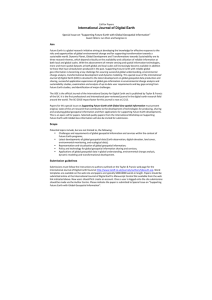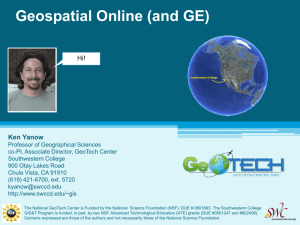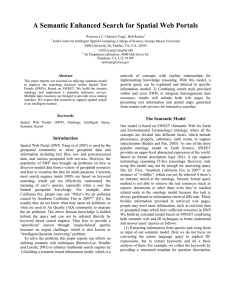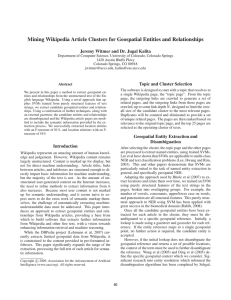Media Watch on Climate Change • US Election 2004 Web Monitor
advertisement
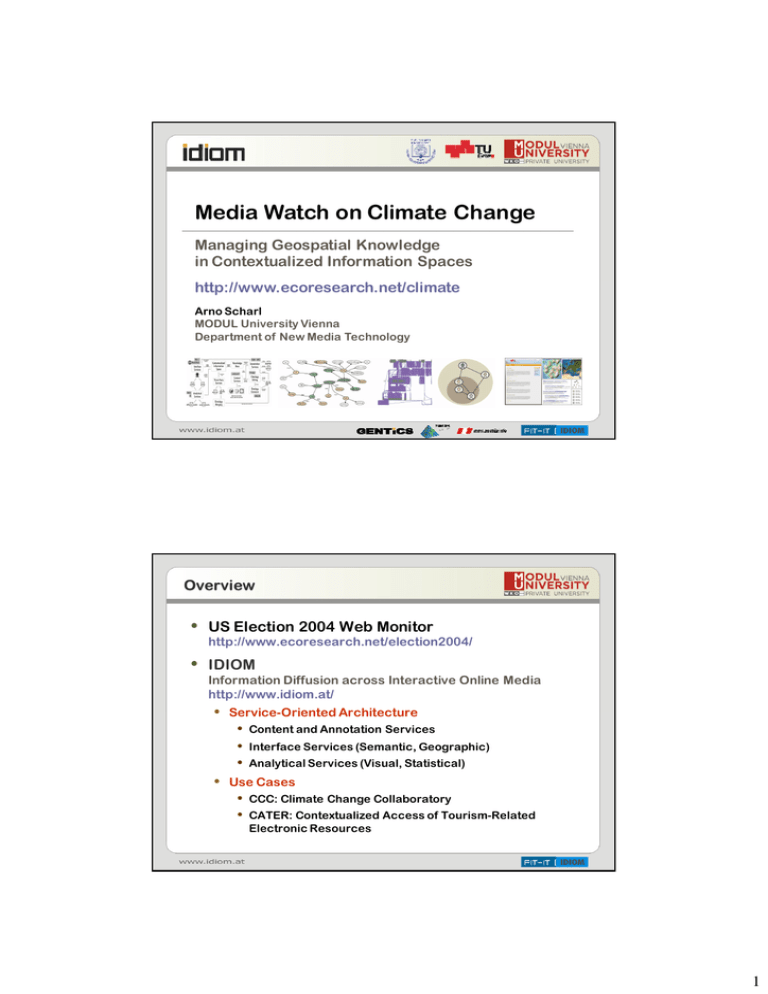
Media Watch on Climate Change Managing Geospatial Knowledge in Contextualized Information Spaces http://www.ecoresearch.net/climate Arno Scharl MODUL University Vienna Department of New Media Technology Overview • US Election 2004 Web Monitor http://www.ecoresearch.net/election2004/ • IDIOM Information Diffusion across Interactive Online Media http://www.idiom.at/ • Service-Oriented Architecture • Content and Annotation Services • Interface Services (Semantic, Geographic) • Analytical Services (Visual, Statistical) • Use Cases • CCC: Climate Change Collaboratory • CATER: Contextualized Access of Tourism-Related Electronic Resources 1 Research Questions • How widespread is content redundancy, and what influences content replication within and across social networks? • Does media interactivity influence information diffusion? Can existing models such as hub-and-spoke, syndication and peer-to-peer explain this influence? • Which content placement strategies increase the impact on the target audience and support selfreinforcing content propagation in virtual communities (viral marketing)? • Impact of macroscopic information flows on environmental awareness and public opinion? What are appropriate methods to measure and model the extent, dynamics and latency of this process? US Election 2004 Web Monitor 2 US Election 2004 Web Monitor Time Magazine, Magazine Sep 27, 2004Vol. 164 No. 13 Sou rce: ABC News/Washington Post, CBS News/ New York Times, CNN/USA Today/Gallup Web Mining Architecture 3 Interface Services • Semantic Interfaces • Perceptual Maps (US Election Monitor 2004) • Information Landscapes (Aureka, VisIslands) • Ontology-based Visualizations • Geospatial Interfaces The Geospatial Web “may ultimately be the big disruptive innovation of the coming decade” (Erle et al. 2005, xxv). • 2D Platforms • MapQuest • Google Maps • Yahoo! Maps • 3D Platforms • NASA World Wind • Google Earth • MS Virtual Earth WebMap CIA World Factbook Technologies Perceptual Maps 4 Thematic Maps Aureka InfoSky VisIslands Ontology Services 5 www.austria.info The Geospatial Web • Integrates • Cartographic Data • Environmental Indicators • Geotagged Hypermedia • Knowledge Planets • Topology of Information Landscape • Peak = Cluster of Documents on a Specific Topic • Valley = Sparsely Populated Part of the Information Space • Projecting Information Landscapes onto Virtual Globes • Initial Arrangement and Stability of Topics • Navigation Across Layers and the 0° Meridian Line • Download | www.geospatialweb.com/chapter-1 Scharl, A. (2007). “Media Platforms for Managing Geotagged Knowledge Repositories”, The Geospatial Web – How Geobrowsers, Social Software and the Web 2.0 are Shaping the Network Society. Eds. A. Scharl and K. Tochtermann. London: Springer. 3-14. 6 Media Watch on Climate Change Contextualized Information Space Collaboration platform and knowledge repository annotated along multiple dimensions • Urgency and scope of environmental problems call for both immediate action and sustainable long-term strategies (Time) • ICT transform the way we handle the explosive growth and reduced lifespan of environmental knowledge (Semantics) • Interdependency of micro- and macro-level indicators and strategies > e.g. “Think globally, act locally!” (Location) Media Watch on Climate Change • Public Web Portal http://www.ecoresearch.net/climate/ • Extraction of Environmental Knowledge 150 200,000 10,000 Anglo-American News Media Sites Documents (Mirrored in Weekly Intervals) Environmental Articles • Contextualized Information Space Annotate Source and Target Geography BBC: „Vienna Marking Mozart Milestone“ Source: Europe | United Kingdom | London Target: Europe | Austria | Vienna Semantic Classify Documents, Assign Ontology Concepts Spatial Temporal Add Timestamps to Publications, Events, etc. 7 Climate Change Media Watch Climate Change Media Watch w w w.geospatialweb.com 8 Analytical Services New Media Trends • Social Computing and the Web 2.0 • Governed by strong network effects and harnessing collective intelligence through customer-self service and algorithmic data management (O'Reilly 2005) • Blur the distinction between content production and content consumption • Hybrid Models of Content Production • Individual (Monographs, Blogs) • Cooperative • Hierarchical (Newspaper Articles, Edited Books, • Traditional Encyclopedias) • Evolutionary (Groupware, CMS, Wiki) Automated (News Aggregators) 9

